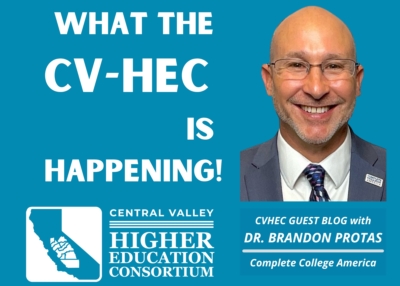‘What the CV-HEC is Happening’ Blog (Summer 2025): Dr. Brandon Protas, Complete College America
For this summer edition of our “What the CV-HEC is Happening” blog, we feature Dr. Brandon Protas, assistant vice president for Alliance Engagement for Complete College America (CCA) based in Indianapolis. The Central Valley Higher Education Consortium (CVHEC) is one of 53 affiliates — states, systems and consortia — participating in the CCA Alliance nationwide. Dr. Protas, who resides in Colorado, was invited to Fresno for the CVHEC Summit in May to present on the panel, “Data at Every Level: Sharing National, State and Local Insights” (above). He addressed national trends in higher education, college completion rates and his higher education experiences nationwide. In this blog, Dr. Protas shares observations from the summit noting that CVHEC is a national model for strengthening higher education’s impact through unity and collaboration and the summit served as a clarion call in today’s climate of hostility against diversity, equity, inclusion and accessibility as well as undocumented students. CCA is now preparing for its national conference set for Nov. 17-19 in Baltimore that is attended by a CVHEC delegation.
Reflections from the CVHEC Summit 2025: regional unity and collaboration
a national model for strengthening higher education impact
Assistant Vice President for Alliance Engagement
I was honored to participate in the 2025 Central Valley Higher Education Summit which showcased the remarkable power of collaboration across California’s educational sectors May 8 and 9 in Fresno.
 It was my first visit to this Central California city and the annual summit that is presented by the Central Valley Higher Education Consortium that comprises 28 institutions of higher education in the 10- county region. The consortium is a partner in the Complete College America alliance.
It was my first visit to this Central California city and the annual summit that is presented by the Central Valley Higher Education Consortium that comprises 28 institutions of higher education in the 10- county region. The consortium is a partner in the Complete College America alliance.
The time in fellowship I experienced at the 2025 CVHEC Summit highlighted the collaborative approach of the Central Valley region and serves as a national model for strengthening higher education’s impact through unity and collaboration.
I saw first-hand how the Central Valley higher education momentum that emerged over those two days (the first day was a reception alive with genuine fellowship) provides an essential force to the nationwide movement for increased attainment rates.
In the West, the Central Valley stands out in its approach to higher education, illustrated by opening comments from University of California, Merced Chancellor Juan Sánchez Muñoz and chair of the CVHEC Board of Directors who noted this gathering was a reflection of how the colleges and universities operate together in the region through a spirit of cooperation rather than competition.
The building of solutions among the state’s four segments of higher education – the California Community Colleges, the California State University, the University of California, the Association of Independent California Colleges and Universities — played out throughout the summit and is a model worthy of attention.
For example, the Central Valley is focused on a number of pathway programs to open opportunities for students with multiple points of entry and connection. This includes dual enrollment initiatives, the Math Bridge Project, and the Transfer Project with its Program Pathways Mapper app for students, all of which were highlighted as essential tools for student success. These initiatives exemplify the region’s leadership in creating seamless educational journeys for students. This impact was reinforced by a panel of students whose testimony reminded us that their successes are direct outcomes of these programs.
Another theme of the summit was noted by Dr. Carole Goldsmith, chancellor of the State Center Community College District, who captured the essence of the event when she observed that a gathering like this has a restorative power for educators to draw strength from each other.
This sentiment resonates deeply in today’s challenging educational landscape and is paired with the importance of constructing and maintaining unified messaging.
For example, the transformative impact of financial aid on students’ ability to achieve their postsecondary goals is at risk. The billions of dollars of financial aid that students across the state receive not only impacts individual lives but also strengthens institutions and regional economies. By bringing together the power of the collective whole, the region can stay strong and advocate for policies that do support rather than harm students.
A powerful call-to-action that emerged throughout the summit is to amplify student stories, demonstrate higher education’s local economic impact, and preserve support programs that enhance student wellbeing. We heard that the Central Valley has only become more excellent as it has become more diverse.
This serves as a clarion call in today’s climate of hostility against diversity, equity, inclusion and accessibility as well as undocumented students. As was noted in the summit, California is and has been compliant with state and federal laws on these issues. The law hasn’t changed, and therefore neither should the practices that support students.
CCA looks forward to continued collaboration with our alliance partner CVHEC as we work on various national initiatives together enroute to our national conference Nov. 17 in Baltimore.
(CVHEC blog submissions are welcome for consideration: Tom Uribes, cvheccommunications@mail.fresnostate.edu).



